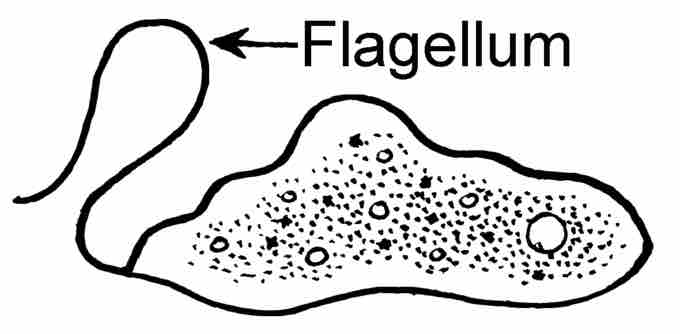The opisthokonts, or "fungi/metazoa group", are a broad group of eukaryotes, including both the animal and fungus kingdoms, together with the eukaryotic microorganisms that are sometimes grouped in the paraphyletic phylum choanozoa (previously assigned to the protist "kingdom"). Both genetic and ultrastructural studies strongly support that opisthokonts form a monophyletic group.
One common characteristic of opisthokonts is that flagellate cells, such as most animal sperm and chytrid spores, propel themselves with a single posterior flagellum . This gives the group its name. In contrast, flagellate cells in other eukaryote groups propel themselves with one or more anterior flagellae. Most fungi do not produce cells with flagellae, but the primitive fungal chytrids do, suggesting that a common ancestor of current fungal species did have a flagellum.

Flagellum
Here is a depiction of a unicellular organism with a flagellum. Flagellum are a typical structure found on opisthokonts, sometimes at only specific points of the a life cycle.
The close relationship between animals and fungi was suggested by Cavalier-Smith in 1987, who used the informal name opisthokonta (the formal name has been used for the chytrids). The discovery was confirmed by later genetic studies. Early phylogenies placed opisthokonts near the plants and other groups that have mitochondria with flat cristae, but this character varies. Cavalier-Smith and Stechmann argue that the uniciliate eukaryotes such as opisthokonts and Amoebozoa, collectively called unikonts, split off from the other biciliate eukaryotes, called bikonts, shortly after they evolved.
Opisthokonts are divided into Holomycota or Nucletmycea (fungi and all organisms more closely related to fungi than to animals) and Holozoa (animals and all organisms more closely related to animals than to fungi); no opisthokonts basal to the Holomycota/Holozoa split have yet been identified.